One of the most important fluids in your car is the coolant. Your engine won’t be able to run for even one minute without significant catastrophic consequences if the coolant level is improper. Because of this, you must become familiar with the typical signs that the coolant level is dropping as a driver.
You’ll experience significant breakdowns when the coolant level falls below a predetermined level. Because of this, you should look for early low coolant symptoms before it gets that bad and you have to deal with irreparable damage.
You can learn everything you need to know about the most common low coolant symptoms in a car from this article. To prevent your car from topping off, you must act appropriately whenever you notice any of these symptoms and stop.
It’s important to keep in mind that in some local circumstances, you might need to tow your car to the closest garage to fix other problems that could be the reason the coolant level drops.
Why Does Your Vehicle Need Coolant, and What Does It Do?
It’s important to take a step back and understand how the cooling system functions as well as what could go wrong when the coolant level drops before highlighting the most common low coolant symptoms.
Antifreeze and water are combined in coolant at a 50/50 ratio. When the engine temperature rises above the maximum limit, this coolant circulates through the engine and its various hot components to reduce it.
The coolant freezing and boiling temperatures are not typical due to the water and antifreeze combination, which enables the school hunt to withstand extreme conditions without any problems.
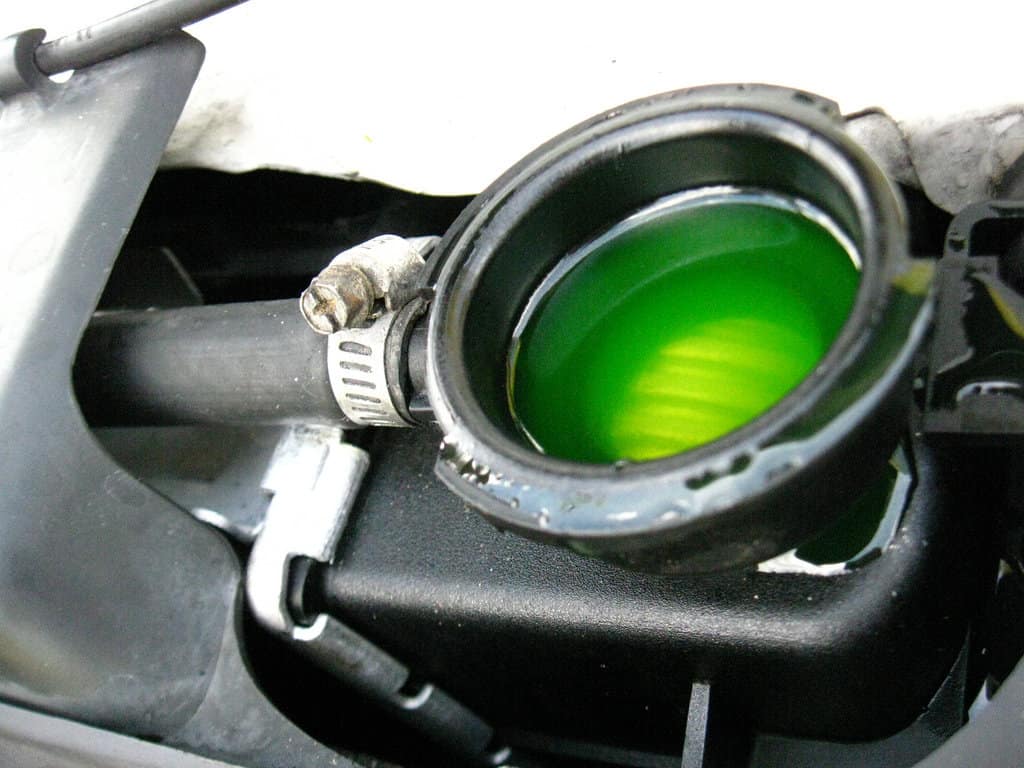
Antifreeze in the radiator by EvelynGiggles / CC BY 2.0. In coolant, antifreeze and water are mixed equally. This coolant runs through the engine and its different hot components to lower the temperature when it exceeds the maximum limit.
The level at this moment might decline below a particular point for various reasons. This occurs because your engine does not get enough liquid to cool it down. As a result, you may experience a variety of negative effects, from a slight increase in engine temperature to serious engine damage.
Which are the Common Low Coolant Symptoms In a Car?
You should now be able to recognize what Google doesn’t do incorrectly when the current level falls below a predetermined threshold. The following are the most common low coolant symptoms that are crucial for you as a driver to become familiar with:
1. Substantial Drop In Fuel Efficiency
The high engine temperature can also reduce your car’s fuel economy. The coolant pump has to work harder to remove the excess heat when your engine is running hot. The water pump is under a lot of pressure as a result.
Putting aside the stress on the pump, increasing heat removal rates necessitates using more engine power. The engine will use more gasoline if it has to produce more work—the decrease in fuel efficiency.
When you notice that your engine is using more fuel than it should, that is the first and most obvious sign that your coolant level has dropped. This is referred to as high fuel consumption or low fuel efficiency.
Remember that if your engine uses more fuel than it should, there could be some other problems at play. Therefore, we cannot assume that it is a local level right away unless your mechanic confirms or observes additional symptoms that point to the same cause.
2. Leak of Coolant
The level of the coolant will eventually fall as is normal. However, if you notice that the coolant level is rapidly declining, it might be a problem with coolant leakage.
Therefore, you must stop your car right away if you notice that fluid is dripping from underneath it. Even though there may be a long list of other fluids in your car, this one could be one of the most crucial ones, such as the coolant or possibly the engine oil.
As a result, before you take your car out for even a minute, you must consult a mechanic. If you don’t, you could end up with severe damages that will cost you thousands of dollars to fix.
3. The Radiator Cap Is Problematic
When there is a local level, you may occasionally notice that the radiator cap is not in good condition; in other words, it may begin to spell out coolant, which is a sign that the cooling system is malfunctioning.
After starting the engine, you must never touch the cooling cap. This is because the cooling system will be very hot and that opening the cap will cause a tremendous amount of steam to pour out, creating potentially dangerous conditions.
So, if you think there might be a problem with the cooling system, you should wait at least 15 to 20 minutes before touching anything near the engine hood.
If you have a bad radiator cap, fixing it should remedy your problem quickly. A new radiator cap may be purchased for not very much money, and changing the radiator cap is not a difficult task.
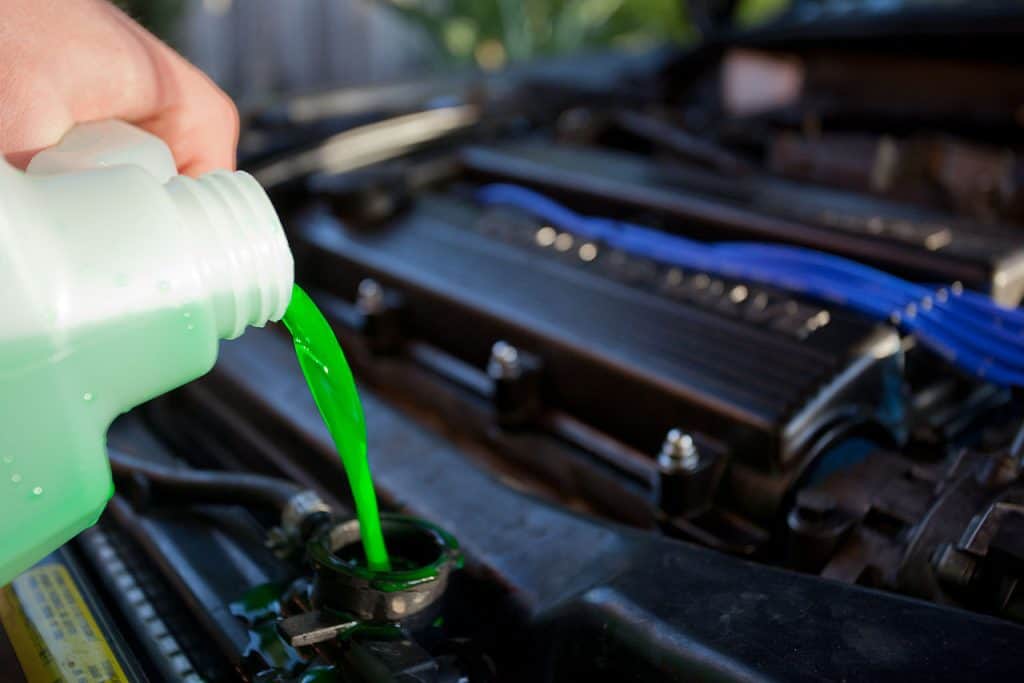 The coolant is poured into the radiator of an automobile by Fir0002 / GFDL 1.2. Problems with the car’s heating and air conditioning system could also be brought on by low engine coolant. The heater in the car makes use of the heat that the coolant eliminates. If the heater is unable to generate the required heat, you will have inferior performance.
The coolant is poured into the radiator of an automobile by Fir0002 / GFDL 1.2. Problems with the car’s heating and air conditioning system could also be brought on by low engine coolant. The heater in the car makes use of the heat that the coolant eliminates. If the heater is unable to generate the required heat, you will have inferior performance.
4. Having Issues with the Heater
It may be a local problem if the heating system isn’t functioning properly. The cooling system and heating system are connected in some way, and the heating system absorbs the necessary heat from the cooling system to heat the interior of your car.
As a result, if you’ve ever tried to switch on the heating system but noticed that no hot air is coming out of it, it may be a coolant issue.
5. The Overflow Reservoir Has Problems
The overflow reservoir may occasionally indicate a problem with your cooling system. As a result, carry out a twofold examination and examine the reservoir. You’ll need to check the cooling system and top it off or drain some of the additional coolants if you find that it’s above the minimum or maximum marks.
6. The Pleasant Aroma
If you notice that your car and the terror smell sweet, it may be because the cooling system is leaking. The entire freeze usually has a pleasant scent. Of course, regardless of whether a strange smell is nice or harmful, you must take it seriously.
Inhaling the entire frozen over an extended period could be exceedingly dangerous and result in health issues. As a result, you must contact your mechanic as soon as you become aware of it to get the problem fixed.
7. An Overheated Engine
The engine will continue to overheat if the cooling system isn’t functioning properly until it reaches a very high temperature. Therefore, you should check your coolant level if you see that the temperature gauge on the dashboard is rising sharply since it may be low.
The engine temperature gauge increases along with the engine temperature when the coolant level is low. A car’s temperature gauge ought to display the best possible reading. It may be higher than, lower than, or anywhere in between. Anything above this can be viewed as an oddity and is invariably cause for concern.
The engine may be in danger of malfunctioning if the temperature gauge continues to rise. Stop the car as soon as the temperature gauge reads incorrectly. Driving it now is dangerous and can have disastrous effects.
Other factors, such as poor engine oil, might also contribute to a hot engine. So, always conduct a diagnosis to determine what went wrong. But when the engine is still hot, do not attempt to open the radiator pressure cap. It can burn your flesh by sputtering hot coolant out.
To check the coolant level in your radiator, let your engine cool down, ideally overnight. Tanks for coolant reservoirs are typically transparent. Most of the time, all it takes to identify low coolant symptoms is to do a quick peek at the optimal level markings.
8. Warning Light for Low Coolant
This is one of the most obvious and easiest-to-understand low coolant symptoms. It can also come with a notice telling the motorist to add additional coolant.
The emblem of a thermometer dipped in a liquid could be displayed on the warning light. Some cars may also have the symbol for a tank with insufficient fluid.
The low coolant warning light denotes the same thing regardless of the icon. Pull aside, let your car cool completely, and then add the proper amount of coolant, as directed by the manufacturer, to the reservoir tank or radiator.
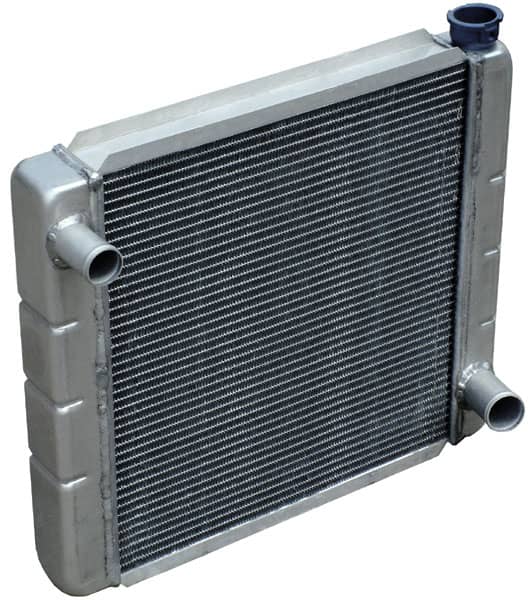
The radiator hoses of a car are quite close to the engine and are exposed to high temperatures when the engine is running. If the hoses rupture or fracture, coolant may flow out of the system.
9. Constant Hot Air from AC
If the coolant system is not in good shape, the cooling system of the car won’t function properly. Your car’s thermostat valve may trip as a result of an overheated engine. It will make the AC less effective. Additionally, the AC in your automobile may start blowing hot air instead of cool.
Low engine coolant might also cause issues with the car’s air conditioning and heating system. The heat that the coolant removes is used by the car’s heater. You receive the heater’s subpar performance if it doesn’t produce the necessary heat.
10. Engine Cuts Off Automatically
Your vehicle’s engine can shut down automatically if the coolant level is low. The engine’s excessive temperature is once more the problem. A proper operating temperature has been selected for the engine.
The engine will automatically shut power when the temperature reaches that point or drops below it to avoid damage. In addition, if the engine coolant is low, starting the car could be challenging.
Which are the Common Reason of Low Coolant Symptoms?
Coolant leaks result in engine overheating, which eventually leads to engine failure and expensive auto repairs.
Engine overheating is inevitable when using the incorrect coolant or while operating a vehicle with insufficient coolant in the reservoir. Depending on the state of the car’s engine, the environment, the driver’s negligence, or a defective engine component, there are various causes of coolant leaks.
Although the coolant evaporation rate might occasionally be relatively low, which causes genuine perplexity to the auto caretaker, these coolant losses are not acceptable. Let’s look into what can be causing coolant loss.
1. A Broken Head Gasket
The head gasket blowing up causes the most serious damage to a car engine. Low coolant levels could cause damage to the head gasket or cause the coolant level to decrease dangerously quickly.
The car’s exhaust system and catalytic converter are harmed when coolant enters the combustion chambers of the engine and burns off. When the head gasket blows, coolant enters the combustion chamber and damages the engine block or cylinder head, which causes the engine to emit white smoke.
2. Faulty or Rusted Reservoir Cap
When the rubber on the radiator cap is worn out or rusted, the rate of coolant evaporation is fairly low. The major function of the radiator cap is to maintain the reservoir pressure and coolant level so that the coolant can circulate normally along the hose.
Damage causes the coolant to leak and the reservoir’s pressure to drop, which activates a dashboard warning light. The reservoir cap should be replaced after a few years, and it should be inspected twice a year for rust or rubber damage.
3. Worn-Out or Damaged Radiator Hoses
When a car’s engine is running, the radiator hoses are quite close to the engine and are subject to extreme temperatures. The system’s coolant may leak out as a result of the hoses cracking or bursting.
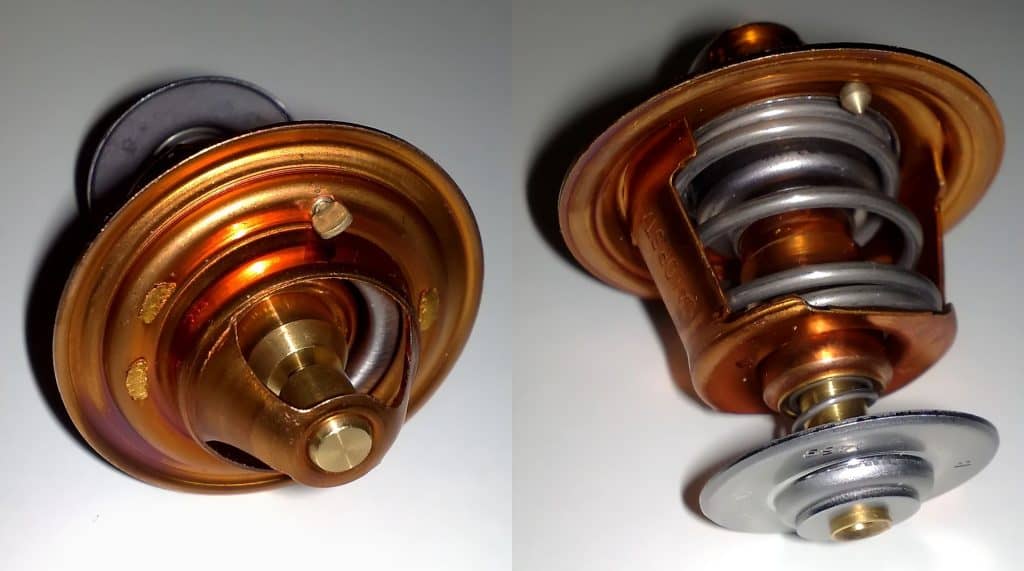
Car engine thermostat by Hoikka1 / CC BY-SA 3.0. An engine block or cylinder head is normally located above the thermostat housing, which is a coolant outlet. Coolant is transported from the engine block to the radiator via the thermostat housing.
This results in a low coolant level warning, and the ongoing spillage will negatively impact the head gasket, leading to engine problems.
4. Leaking Radiators
The lightweight yet useful aluminum radiator controls the hot and cold coolant temperatures and preserves the overall pressure in the engine compartment.
Due to the high temperatures nearby, the radiator is severely damaged. When water is used in place of coolant, the radiator walls corrode because the coolant is of poor quality.
Rust, which develops from corrosion, eventually rips holes in the radiator’s surface and lets water flow.
5. Defective EGR Cooler
A break inside the EGR cooler is the last item on this list that can result in low engine coolant. You must first check to see if your engine has an EGR cooler because not all automobile engines have one. They are primarily present in European automobiles.
White smoke will also come from the exhaust pipe as a result of coolant leaking into the pipe due to a broken EGR cooler.
6. Intake Manifold Gasket Failure
There are coolant tubes within many intake manifolds because they use coolant to cool the intake air. So a gasket is put between the intake manifold and the cylinder head.
This gasket may begin to leak, which will result in the coolant being sucked into the engine and burning. If you observe white smoke coming from the exhaust pipe, you can usually tell what it is.
7. An Exterior Coolant Leak
External leaks are the most frequent cause of low engine coolant levels, as we already mentioned. Any component of the cooling system could be the source of an external coolant leak. Fortunately, external coolant leaks are frequently noticeable, making it simple to pinpoint their source.
The water pump, radiator, and the area around the thermostat are typical sources of exterior leaks.
8. A Damaged Cooling System
Other parts of the engine, besides the coolant itself, are in charge of preserving engine temperatures. The engine’s primary cooling-off components are the water pump, thermostat housing, and radiator fan.
Making sure that coolant passes through the radiator, hoses, and the engine block is the water pump’s main goal. A series of chain reactions that result in coolant loss and engine damage is brought on when the pump fails to push the coolant to the right engine sections.
The thermostat housing is a coolant outlet that is typically placed above an engine block or cylinder head. The thermostat housing is the conduit via which coolant travels from the engine block to the radiator.
Under certain circumstances, a choke-up and coolant leakage on the ground beneath the car occurs when the coolant becomes caught in a closed position with the housing.
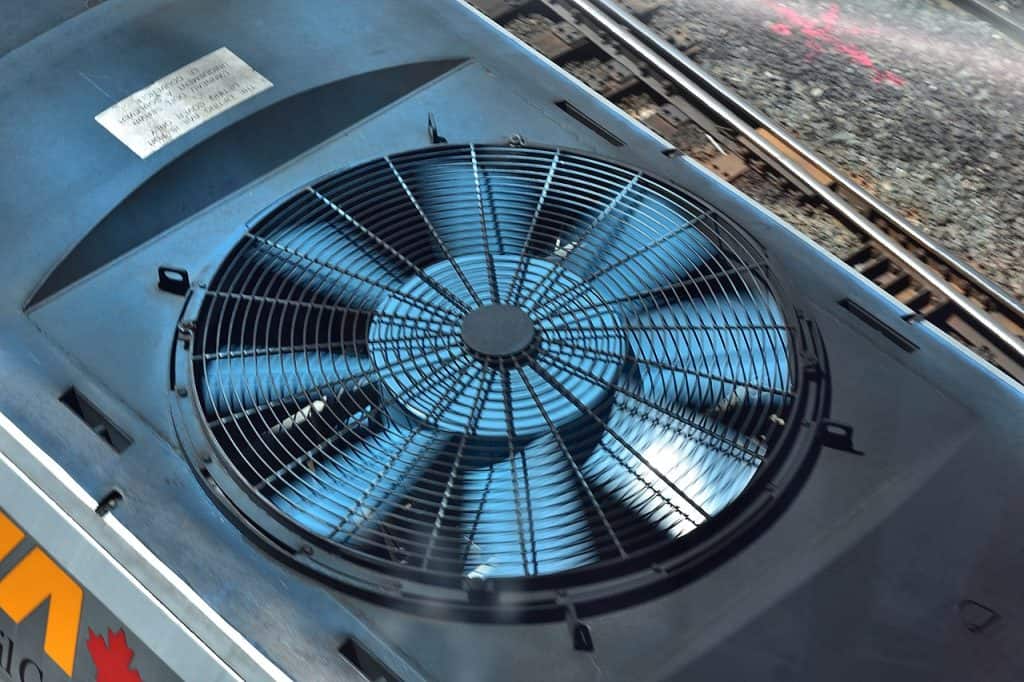
The cooling fan of a radiator by Saud / CC BY-SA 4.0. When an electrical motor fails, the radiator fan may cease, causing the radiator temperature to rise. This could lead to the radiator cap bursting open, the radiator leaking, and fluid loss.
Radiator temperature may rise as a result of the radiator fan stopping owing to electrical motor failure, which could cause the radiator cap to burst open or cause radiator leakage and coolant loss.
What Amount of Coolant Loss Is Usual?
With problems in the radiator or engine, a coolant leak is unavoidable, but there is also a potential of coolant levels dropping without any sign of a leak. Despite not being a closed system altogether, a tiny amount of coolant may evaporate because an overflow reservoir is available.
However, over time, the coolant circulates inside the engine and radiator; the chemical agents lose their natural equilibrium when exposed to high temperatures and evaporate without experiencing any appreciable leaks. The coolant evaporates more and more as the engine ages.
According to a standard calculation, an engine’s coolant level decreases by 0.25% in 4 months for every year it runs, assuming it is in good condition and free of leaks or damage.
Quarterly increments of 0.25 inches equal one inch each year. Due to the extremely high temperatures that transform the water element inside the coolant into steam, this evaporation of the coolant is to be expected.
To extend the life of the engine, it is recommended to clean the radiator and replace the coolant every couple of years.
What Should You Do If the Coolant Level Drops?
If you experience any of the aforementioned low coolant symptoms, you must act promptly to avoid the issue becoming worse. Usually, you’ll need to take the following actions:
1. Remain Calm
Not panicking is the most crucial thing to do when dealing with any automotive issue. Things won’t go as planned if you start to panic since you’ll be too stressed and distracted to take the proper steps.
2. Stop Your Vehicle
If you’re on a highway, you must take the closest exit to find a secure location to stop and pull over your car. However, if the situation becomes grave, you may begin to experience some serious overheating symptoms, which will necessitate stopping your car on the side of the road.
3. Let Your Car Cool Down
Never open anything or touch the hood to inspect it. Give your car at least 15 to 30 minutes to cool down. After that, everything will be exceedingly hot, and there is a very strong likelihood that trying to open the cooling system may result in injury.
4. Find Any Leaks
Look around the car for any indications of coolant leaks. If so, it’s possible that you won’t be able to operate the vehicle and will instead need to wait for the tooling service.
5. Refill the Coolant
You can top the colon and check to see if the issue is rectified and if there are no obvious symptoms of significant leaks. To avoid having to deal with these scenarios, keep some extra coolant in your car at all times.
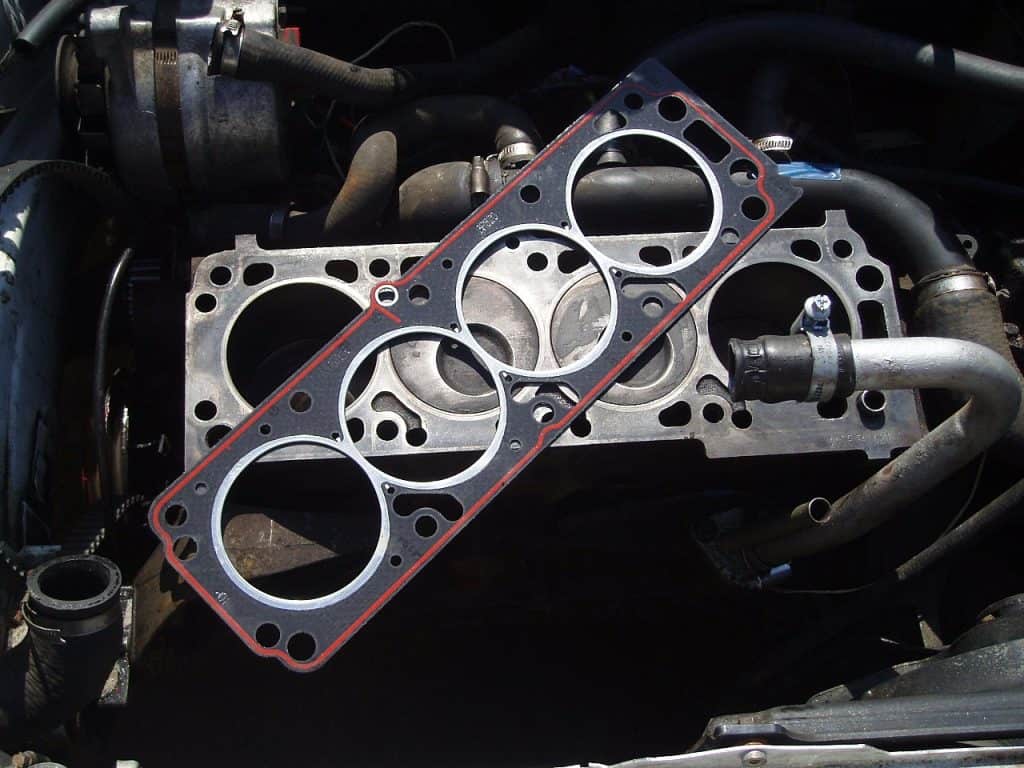
Head gasket on the block by Collard / CC BY-SA 3.0. The worst engine damage comes from a head gasket blowing up. The head gasket may be harmed by low coolant levels, which can also cause the amount to drop dangerously quickly.
If you don’t want a tow service, some automotive professionals may recommend using water instead of coolant for a brief period until you reach the closest repair facility. To find out whether this is okay for your vehicle or not, you must first phone your mechanic.
6. Speak with Your Mechanic
Call your mechanic and explain the situation if you have one. The person who knows your car best, your mechanic, will offer you clear directions on what to do next. However, you might also need to contact your insurance provider and use any available roadside help.
If your insurance coverage doesn’t include a roadside assistance plan, you might consider calling a towing company to have your car transported to the closest garage or reaching out to a family member or friend for assistance.
Which Is the Correct Type of Coolant to Use In My Car?
The owner’s manual for your car should have comprehensive instructions on the proper coolant to use. However, you may also buy a higher-quality coolant that has specific additives to safeguard the car and stop corrosion from accumulating.
The market is filled with numerous instances of top-notch coolants. We strongly suggest you read several articles outlining the key benefits and drawbacks of the top coolant varieties available. Be aware that some coolant types might not work with you, to avoid any unfavorable outcomes that will cost you a lot of money.
How Much Is the Cost of a Coolant Refill?
The price of a coolant replacement might range from $90 to $180 depending on the make and model of your car. The actual coolant is pretty affordable. A bottle of coolant costs between $20 and $30.
The expense of labor makes up the balance. You may pay a professional repair of $60 to $150 for a coolant replenishment. The major objective is to wash out the old coolant and look for leaks; nevertheless, pouring coolant is not a problem.
Is Driving with a Low Engine Coolant Level Safe?
No, driving with low engine coolant levels is not safe. Low engine coolant levels can result in airlocks in the coolant system, and an overheated engine might seize or destroy expensive sections like the engine block.
It is so simple to refill the engine coolant, so it is worth thinking about the effects. Never access the coolant reservoir while the engine coolant is still warm, though!
What are the Consequences of Driving with Low Coolant Symptoms?
The most frequent result of driving with insufficient engine coolant is air in the cooling system, which causes the engine to overheat. A burst head gasket or a broken engine block might result from an overheating engine.
The following is a more thorough description of what can occur if you drive around with low engine coolant:
1. A Cooling System with Air In It
The water pump will pump air into the coolant system, which will result in airlocks in the coolant system, which is the first thing that could happen if you drive about with low coolant.
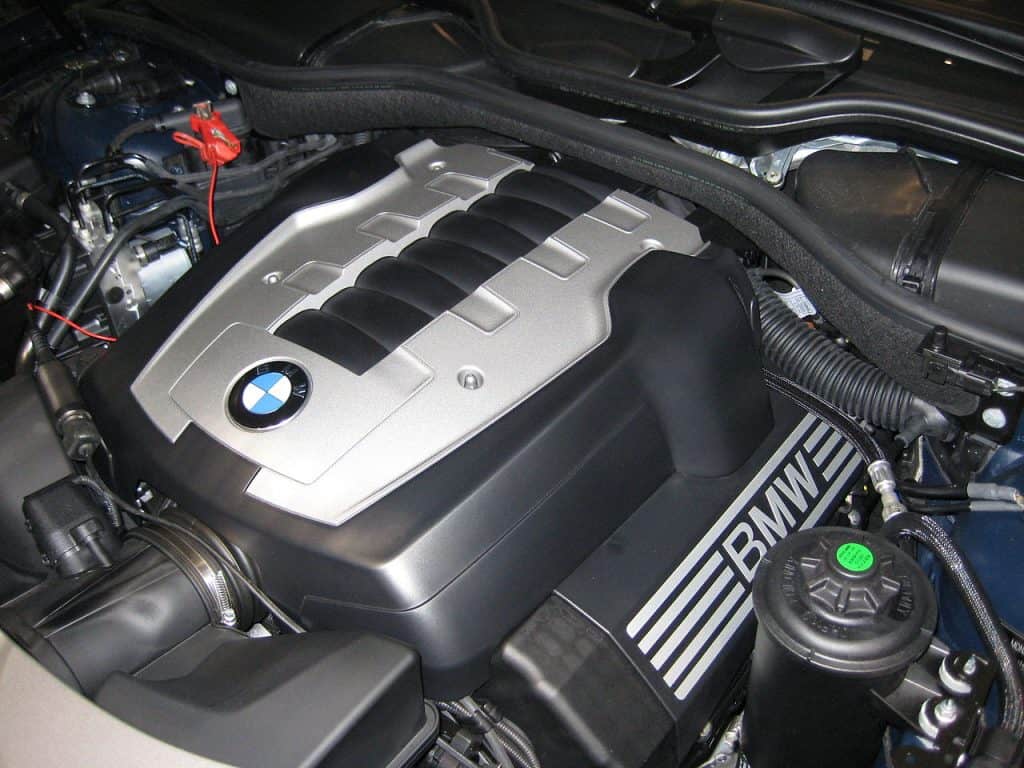
Driving with insufficient engine coolant most frequently results in the air entering the cooling system, which overheats the engine. An overheated engine may result in a ruptured head gasket or a fractured engine block.
Airlocks will disrupt the flow of the cooling system, which will lead to an overheated engine, which we will discuss in more detail in the following section.
2. Overheating the Engine
The water pump won’t circulate the coolant to keep the engine at a healthy temperature as a result of the airlocks in the coolant system we previously discussed, which will lead to the engine overheating.
We go over some of the costly problems that an overheated engine might create in the following sections.
3. The Head Gasket Blowing
A blown head gasket is a very frequent and unfunny occurrence that can occur if your engine overheats as a result of insufficient engine coolant.
The head gasket serves to keep compression, oil, and coolant separate and is situated between the engine head and the cylinder head. Even while changing the head gasket can cost over $1,000 in repairs, that expense pales in comparison to what happens next.
4. Engine Block Damage
A broken or fractured engine block is an even more dangerous problem that can happen if you drive with little engine coolant. Low engine coolant levels can lead to hotspots in the cooling system, as we previously said.
You don’t want an engine block or cylinder head fracture because these hotspots can raise the engine block’s temperature to dangerous levels, which can lead to cracking. You need to swap out the entire engine block to fix it.
5. Stuck Engine
The majority of engine components are constructed of metal, which, as you may already be aware, can expand and contract in response to changes in temperature.
If the engine cannot maintain the temperature, engine parts may expand to such an extent that damage results and the engine seizes.
Typically, the only option to fix a seized engine is to disassemble the entire engine to identify the problem.
The Conclusion
The coolant in your car is arguably the most important of all the fluids. It avoids engine overheating, which could result in expensive repairs if the issues are serious.
You now have seven local-level symptoms to watch out for thanks to this post. You must take these symptoms seriously and see a mechanic as soon as you detect any of them to have the problem fixed as soon as possible.
Unfortunately, finding the issue rarely enables you to protect your car and save on maintenance expenditures.


Coolant poured into radiator by Fir0002 / GFDL 1.2

Jim Wicks is the founder of MotorVehicleHQ. With over two decades of experience in the automotive industry and a degree in Automotive Technology, Jim is a certified car expert who has worked in various roles ranging from a mechanic, car dealership manager, to a racing car driver. He has owned more than 20 cars over the past 15 years. Ask him about any vehicle you see on the road and he can tell you the make, model and year. He loves the aesthetics of all things cars, and keeps his vehicles in pristine condition.
In his free time, Jim enjoys getting his hands dirty under the hood of a classic car or taking long drives along the country roads. His favorite car? A 1967 Shelby GT500, a true classic that, according to Jim, “represents the pure essence of American muscle.”